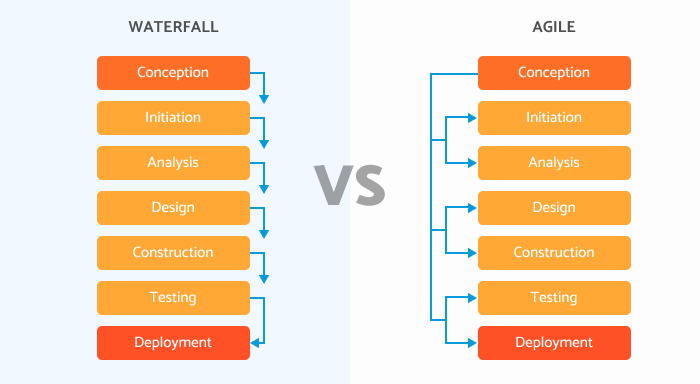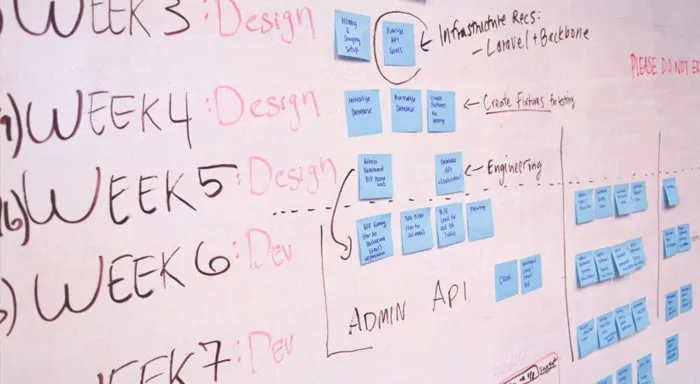What we do
Services
Experts in
Thousands of mobile apps hit the market every day. Each required (or should have required), a carefully selected development methodology. A software development process methodology governs how a software team attacks the mobile app development process. There are two key strategies: agile application development and waterfall application development. We’ll discuss them both below and then give our opinion on which one is the best fit for your project (hint: it’s probably agile development).
All mobile app development methodologies cover the same basic steps to app construction. Though every publication and company may parse these areas a little differently, here’s our basic list of the seven steps to app development:
Conception- where the scope, audience, and fundamental value of your application are decided. This stage determines your focus in each of the following steps.
Initiation- the first, preparatory steps of making your app’s concept a reality are put in motion—a team is hired, and several clear objectives and deliverables are proposed.
Analysis- also called a feasibility analysis, in this step, you and your team validate and determine whether the objectives and deliverables you proposed during initial preparation are feasible.
Design- the skeleton and structure of the app emerge through wireframing, storyboarding, and mock-ups. The app’s overarching design is honed, typically through multiple rounds of revision and reworking.
Construction- here, the app’s design is finally committed to code. Typically, different parts or features within an app are constructed in tandem or one after the other.
Testing- though one of the keys to good testing is incremental tests and quality assurance throughout the steps above, a final round of testing is always a good idea after a feature’s construction.
Deployment- your app is rolled out, either to the wider public, beta users, a closed group of testers, or some combination of the three.
In this post, we’re going to discuss how two different types of development methodologies—agile vs. waterfall- tackle each of these steps.
The waterfall process model follows a more traditional strategy. It tackles each of the steps listed above in a distinct, chronological order. An app’s design, for example, is completely laid out and decided upon before moving onto construction. And, similarly, an app’s construction is completely finished before testing begins.
Check out this illustration for a visible representation of waterfall vs. agile.

The blueprint for agile methodology evolved to address several shortcomings in the more traditional waterfall development process. And the word “agile” actually describes the model’s philosophy pretty well. The agile approach to mobile app development adopts a different strategy for attacking these development steps.
Instead of finishing one step before moving onto the next, agile application development enables teams to set and pursue incremental goals in each of these areas simultaneously.
These incremental goals are typically met via sprints. In a sprint, team members are given a clear, accomplishable goal and a firm deadline for achievement (typically about a week). As we’ll discuss in greater detail below, this approach has some crucial benefits.Basic Agile Principles
Here are the core principles the agile development process is designed to enable:
a more organic, adaptable, and cost-effective approach to mobile app development: the team can shift and adapt to setbacks in any step of the process—even in a later step like testing or construction.
flexibility while maintaining process organization: flexibility and organization are often diametrically opposed. An organized plan is often hardened against adaptation, while a very flexible plan often promotes (or at least allows) procrastination and missed deadlines. By relying on sprints, agile enables developers to adapt by shifting goals and targets while maintaining deadline-central organization.
equal time and effort are given to each step in the process: with an agile methodology, your team doesn’t risk having to completely redo your app’s design or construction due to a fundamental flaw identified in testing (or worse, identified by users after launch because there wasn’t enough time left over for testing after several delays in reconstruction).
Let’s wade in and compare the two different philosophies and approaches of agile and waterfall mobile app development. We’ll discuss the core structures of each approach in greater detail, but here’s a quick summary.
|
Agile Development |
Waterfall Development |
|
Steps tackled simultaneously via fast time sprints. |
Steps tackled one after the other in an assembly line style. |
|
Issues can be addressed and fixes can be implemented as soon as next week’s sprint. |
When issues are identified, other steps grind to a halt until the problem is addressed. |
|
You will get a better picture of what your app looks like faster—that way you can make suggestions or adjust expectations in real time. |
You often don’t see a working version of the app until just before launch (during the final stages of construction or testing). |
|
Changes are anticipated and expected, not resisted. |
Can make team members resistant to adjusting, improving, and adapting. |
With an agile approach, your mobile app team will set about developing your app in a short time sprints that simultaneously apply each of the app designing steps listed and illustrated above. After your app idea’s initial conception, they won’t just move onto initiation, but also analysis, design, testing, and more.
How To Outsource App Development and How Much Does It Cost
Why is this approach so potentially powerful? Because, contrary to popular belief (and what experienced app developers or coaches might like you to believe) mobile app development is a messy process, and is rarely carried out in discrete, isolated project development phases. Your mobile app’s design, construction, and testing, for example, can and should be closely intertwined.

If a fundamental construction issue or design flaw is uncovered during your mobile app’s development, then your team may have to make tough choices and adapt or adopt a new design facet or construction elements. But, with an agile approach, a pivot or adaptation like this isn’t seen as a setback or even a mistake. It’s simply considered an intentional part of the design process.
And, because the agile process tackles each design step simultaneously, pivoting and making changes to your app’s design, construction and deployment is more cost-effective. Instead of waiting to test until you’ve invested your entire construction budget in a full-fledged, feature rich near-final iteration of your app, your team will test smaller, incremental iterations constantly, making changes, revisions, and improvements as you go.
In the end, more often than not, this agile development process results in an app with a better design, fewer flaws or bugs, and greater usability.
If you’d like to learn more about the agile mobile app development process and how it can be applied to create great results for your app-in-the-making, feel free to reach out to us for a consultation. We offer a full range of development services for many mobile app types.
Compared to the agile process, the waterfall model is a bit clunkier. Though, if your team is experienced and you know exactly what you and your customers are looking for in an app, this process can still prove efficient and viable.
So how, specifically, does the waterfall methodology work? Like the agile methodology, the more traditional waterfall model tackles the same seven basic steps of app development (as listed and illustrated above). But unlike agile, which simultaneously tackles each of these steps, the waterfall method attacks each step sequentially. That means that, before construction, your mobile app is completely designed. And, before testing begins, your app is completely constructed.

While this type of organization does have some appeal—it does, for example, make management easier and may make more sense to application or business owners less interested or engaged with the minutia of mobile app development, this process presents several potential pitfalls.
First, when you follow a sequential approach like the waterfall model’s, it makes it more costly and time intensive to adapt your app when adopting new features or fixing fundamental errors.
In the waterfall method, if you reach the testing stage and uncover a significant bug, you may have to scrap code or construction elements that cost thousands of dollars and hundreds of hours to create.
What’s worse, because of the sunk cost bias, you and your team might decide to keep a less than optimal feature, even if it doesn’t test well, because you’ve already invested so much in its design and development.
Along the same lines, the waterfall development process can tempt your team to take shortcuts in the later project development phases, even though these stages are arguably the most important. If your app launch has a clear, non-negotiable deadline and you encounter unexpected setbacks early on in the development process, you might be forced to cut corners in the later stages of construction or skimp out on crucial testing or deployment processes.
In the end, we believe that the waterfall model is more likely to lead to unforeseen and unplanned project delays. Because waterfall allows little to no flexibility, your team may be forced to make costly changes or avoid changes that would keep your app and concept alive and relevant. That means final products may be less likely to satisfy user expectations.
Agile development’s iterative approach leads to mobile apps with better designs, better code, and better ROI. Why? Because compared to the waterfall model, the agile model doesn’t just acknowledge that mistakes and flaws will occur in the development process—it expects them. And, by enabling simultaneous construction, design, and testing, it allows your team to diagnose, resolve, and engineer around these potential setbacks as they appear.
How to Make a Business Plan For Mobile App Startup
